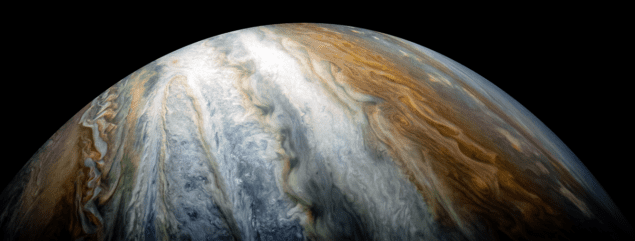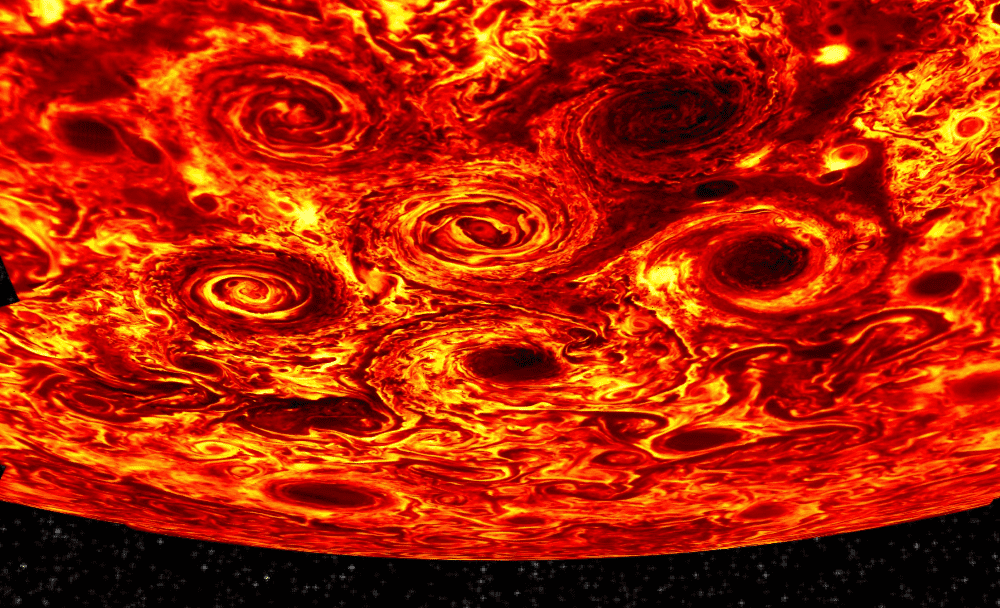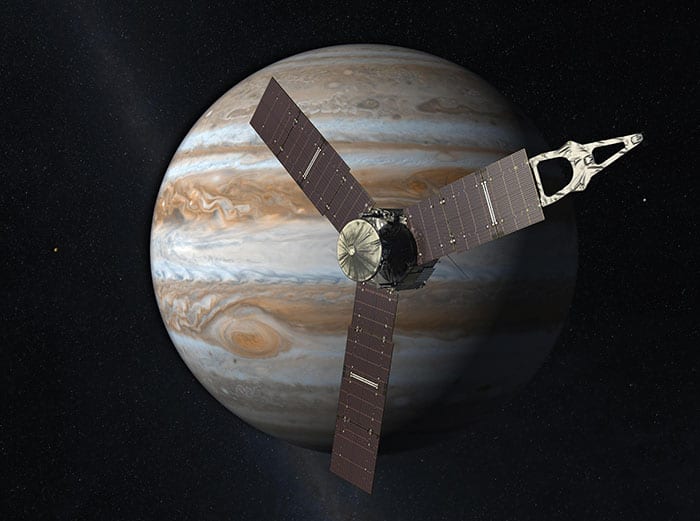
Precise measurements of Jupiter’s gravitational field by NASA’s Juno spacecraft have allowed scientists to make an important connection between surface winds on the planet and motion deep below the surface. The data have also provided new insights into the composition of the core of the giant planet. A separate study by Juno scientists reveals that Jupiter’s north and south poles harbour persistent arrangements of cyclones, an unexpected observation that cannot be explained by current models of the Jovian atmosphere.
In addition to its famous red spot, the surface of Jupiter is covered by alternating light and dark bands that are created by powerful winds. Scientists believe that these bands are driven by energy welling up from the interior via convective cells. But despite calculations and simulations, scientists know very little about how this process occurs in the dense fluid of hydrogen and helium that makes up Jupiter’s interior.
Now in three papers published in Nature, Juno scientists have peered deep into the planet by analysing data derived from precise measurements of its gravitational field.
Doppler shift
In one paper, Luciano Iess and colleagues describe how they mapped Jupiter’s gravitational field by determining the acceleration of Juno as it orbited the planet. This was done by measuring the Doppler shift of the radio waves that the spacecraft sends back to Earth. These data revealed a surprising feature – that Jupiter’s gravitational field is not north-south symmetric about the planet’s equator. This is unexpected for a rapidly-rotating gas giant and is evidence of strong flows within the atmosphere and interior of Jupiter.
Another paper, written by Yohai Kaspi and colleagues, analyses the north-south asymmetry and shows that it is related to a north-south asymmetry of wind speed in the bands visible on the surface. This is strong evidence that the wind bands are not just a surface phenomenon and Kaspi and colleagues calculate that they persist to about 3000::km below the surface. This is about 5% of the distance to the centre of the planet, which means that about 1% of the mass of Jupiter is involved in these winds.
This interpretation of the gravity data is backed up by a third paper, which is by Tristan Guillot and colleagues. This group looked at the symmetrical component of the gravitational field and concluded that, below 3000 km, the Jovian interior rotates like a solid object – despite being a fluid. This supports the idea that the huge pressures inside Jupiter (about 100,000 atmospheres) ionizes hydrogen creating free protons and electrons. The presence of these charged particles is expected to create strong drag forces that suppress flow.

In a fourth paper in Nature, Alberto Adriani and colleagues used visible and infrared observations to show that the planet’s polar regions harbour regular patterns of cyclones that are remarkably persistent. The north pole is home to eight cyclones that circle a ninth cyclone that sits over the pole. The cyclones are all about 4000-4600 km in diameter and their positions and shapes remained more or less the same over hundreds of days of observation. In contrast, the south pole has five cyclones circling a central cyclone. These objects have larger diameters (5600-7000 km) and are also persistent. This is unlike the polar regions of Saturn, which contain one central cyclone.

Brave new Jupiter
The team says that fluid dynamics theory is unable to explain two important aspects of the polar patterns: that the cyclones and the patterns they make do not change appreciable over time, and that the cyclones do not appear to interact with each other.



